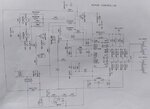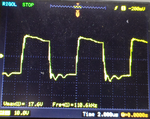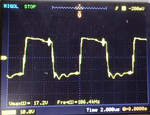abdulrasheedak
Newbie level 3
Hello,
I have an arc lamp power supply board which has a zero voltage switching full bridge converter circuit, utilizing UC3875 controller and IRF840 power MOSFETs. Input voltage is 230V which goes to a PFC circuit which provides 400V for the bridge. OUTA and OUTB terminals of the UC3875 drives one transformer (MOSFETs gate drive for one leg of the bridge). OUTC and OUTD terminals drive another transformer driving the two MOSFETs of the other leg of the bridge. Output voltage is 18V.
It works well for 8A load current. But when I increase it to 12A, only two MOSFETs (One upper and the other lower, of the same leg) are overheating and getting fried in a few minutes of operation. The two MOSFETs of the other legs looks okay.
One observation is that the MOSFETs which are overheating are always those driven by the transformer which is connected to OUTC and OUTD terminals of UC3875. MOSFETs driven by the transformer connected to OUTA and OUTB are fine. When I interchanged the transformer primary connections to UC3875, this held true and the overheating shifted to the other leg's MOSFETs.
I tried increasing the dead time, but it made no difference. Could anyone please suggest how to approach this issue?
This is the controller circuit...

This is the bridge circuit...

Oscilloscope screenshots of controller outputs to the gate driving transformer primaries...


I have an arc lamp power supply board which has a zero voltage switching full bridge converter circuit, utilizing UC3875 controller and IRF840 power MOSFETs. Input voltage is 230V which goes to a PFC circuit which provides 400V for the bridge. OUTA and OUTB terminals of the UC3875 drives one transformer (MOSFETs gate drive for one leg of the bridge). OUTC and OUTD terminals drive another transformer driving the two MOSFETs of the other leg of the bridge. Output voltage is 18V.
It works well for 8A load current. But when I increase it to 12A, only two MOSFETs (One upper and the other lower, of the same leg) are overheating and getting fried in a few minutes of operation. The two MOSFETs of the other legs looks okay.
One observation is that the MOSFETs which are overheating are always those driven by the transformer which is connected to OUTC and OUTD terminals of UC3875. MOSFETs driven by the transformer connected to OUTA and OUTB are fine. When I interchanged the transformer primary connections to UC3875, this held true and the overheating shifted to the other leg's MOSFETs.
I tried increasing the dead time, but it made no difference. Could anyone please suggest how to approach this issue?
This is the controller circuit...

This is the bridge circuit...

Oscilloscope screenshots of controller outputs to the gate driving transformer primaries...

